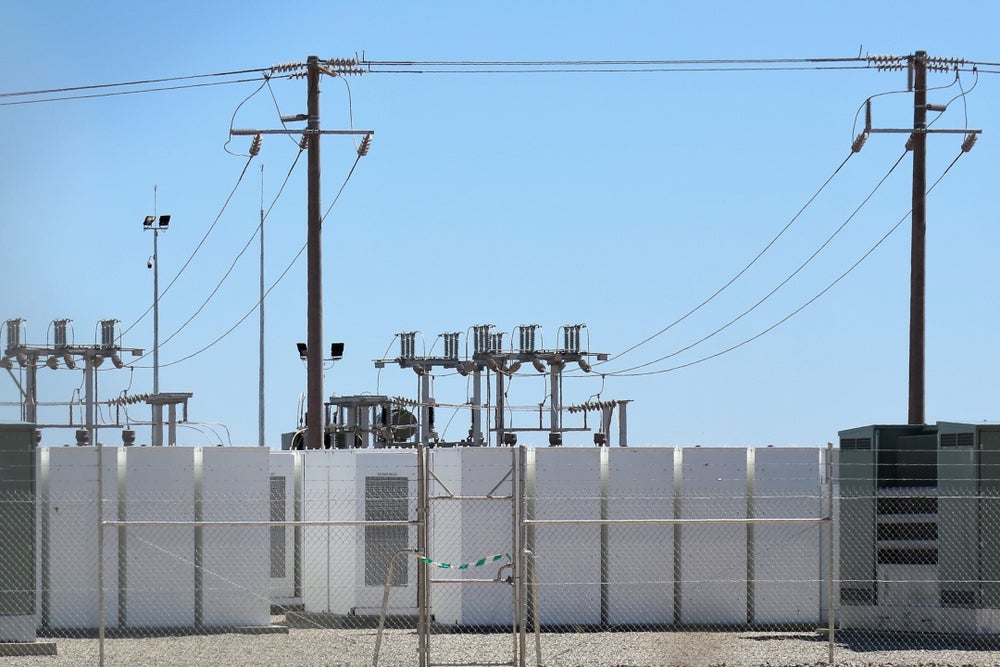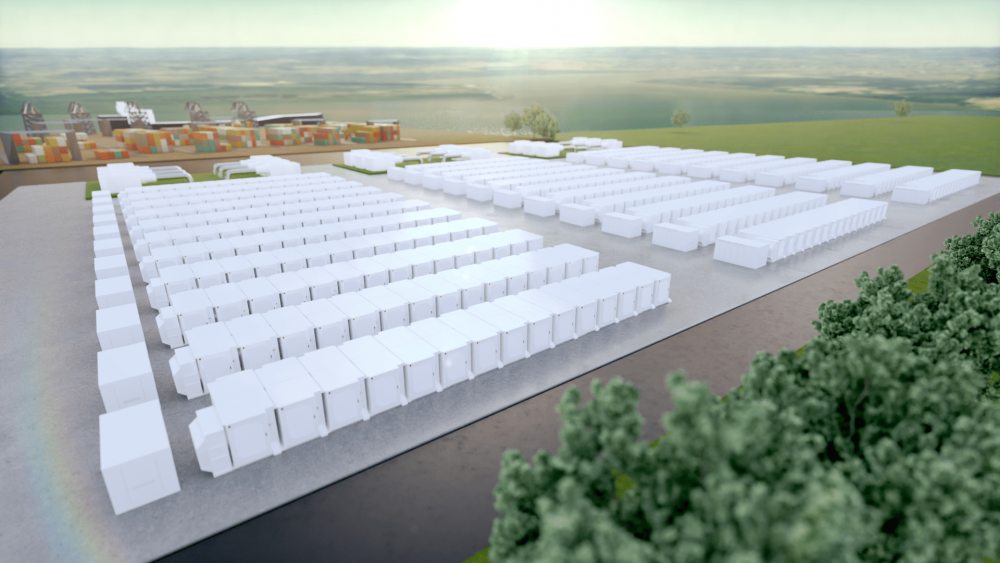
Ramping up capacity in the energy storage market has been identified as a key step in the efforts to help limit the impacts of climate change. Here, Modern Power Systems magazine takes a look at the latest energy storage developments.
AGL has announced Wärtsilä and Fluence (Siemens/AES joint venture) have been secured under non-exclusive framework agreements to supply up to 1000 megawatts (MW) of grid-scale battery storage at sites in Australia, to operate within the country’s National Electricity Market (NEM).
Last year, AGL announced plans to build batteries at Loy Yang A power station in Victoria (200MW), Liddell power station (150MW) and Broken Hill (50MW) in New South Wales and Torrens Island (250 MW) in South Australia.
AGL chief operating officer, Markus Brokhof said Wärtsilä and Fluence were chosen through a competitive tender process “for their capability, experience and pricing as well as their alignment with AGL’s values and strategic objectives”.
“This framework agreement is another example of AGL getting on with the business of energy transition and will enable delivery against our commitment to build 850MW of grid-scale battery storage by FY2024,” he said. “We are already well advanced with our planning process and these framework agreements will reduce tender timeframes for individual projects, enabling shorter project schedules.
“Our grid-scale battery plans provide critical firming capacity to the market and will play a leading role in the energy industry’s transition over the coming decades.”
InterGen’s gateway to big battery
InterGen has received revised Section 36 planning consent for its Gateway Energy Centre project from the UK Department of Business, Energy & Industrial Strategy (BEIS). The Gateway Energy Centre plan envisages the construction of a lithium-ion battery energy storage system with a rated electrical output of up to 1.3 gigawatt-hours (GWh) (320MW) “and/or” an open-cycle gas turbine facility rated at less than 300MW.
The battery would be the largest yet built in the UK, and one of the largest worldwide. When fully charged, the battery could power up to 300,000 typical UK homes for about two hours. However, it will mostly be used to support and stabilise existing electricity supplies by providing fast-reacting power and system balancing.
The plan is to employ Fluence (Siemens/AES) battery technology, based on their Gridstack system. Construction could start in 2022, with operations anticipated to commence by 2024.

The Gateway Energy Centre is planned for construction within the London Gateway Logistics Park, next to the DP World London Gateway Port on the north bank of the River Thames in Essex. InterGen built and continues to operate the existing 800MW Coryton gas-fired combined-cycle power station located about 1km from the proposed Gateway Energy Centre site.
InterGen, which was initially founded some 20 years ago as a joint venture by Bechtel and Shell, and having had several ownership changes since, is now jointly owned by Czech energy company Sev.En and China Huaneng Group/Guangdong Energy Group. It currently owns and operates about 5% of the UK’s power generating capacity.
In addition, InterGen is looking to progress another UK battery energy storage project as part of its Spalding Energy Expansion development in Lincolnshire, England. This would have a capacity of 175MW/350 megawatt-hours (MWh) and has already been granted consent by BEIS.
By way of context, the world’s largest operational battery energy storage project is currently LS Power’s Californian Gateway project having a capacity of 230MW/230 MWh, with an expansion of 250MW/250MWh currently underway. Further similar development projects are located in Australia, the US and Saudi Arabia, with target facility capacities of up to 400MW/1.6 GWh.
Ramboll has supported InterGen on both the Gateway Energy Centre and Spalding Energy Expansion developments since their inception, providing engineering and environmental consultancy services for the battery storage consents since 2014.
Ramboll said its support “has been significant in the successful consenting of the projects, which have included testing of UK regulations and government guidance for these ‘first-of-a-kind’ development projects.”
UK’s biggest battery, for now
Gresham House Energy Storage Fund and flexible energy specialist Flexitricity have announced that what they describe as “the UK’s largest battery”, the Gresham House 50MW/75MWh installation, in Thurcroft, England, is now live “generating revenue for the site while helping National Grid ESO balance supply and demand”.
The asset went live in the Balancing Mechanism (BM) Reserve from Storage Trial and was then live in the BM immediately afterwards. Through the BM, providers can offer to increase or decrease their generation or demand to help balance the system. Flexitricity monitors the BM round the clock from its 24/7 control room and remotely alters the charge and discharge profile of the Thurcroft battery.
The project will also trade the battery in the wholesale markets and tender for frequency response services.
Flexitricity took the asset into National Grid ESO’s new Dynamic Containment frequency response service on day one and “has been securing daily contracts at high value ever since”, said Flexitricity, which notes the UK now boasts about 1GW of battery storage capacity, but further growth is needed to facilitate a net-zero energy system.
Andy Lowe, director at Flexitricity, said: “Investors are getting comfortable with the business case for energy storage and it’s great this year to be seeing a number of large batteries coming onto the system, providing more of the rapid response flexibility National Grid ESO needs to maintain system stability.”
Ben Guest, managing director, Gresham House, said: “We have plans to grow our energy storage portfolio, aiming for more than 350MW in operational assets by the end of 2020. Great Britain needs at least 10GW in the next few years to enable the orderly transition to a renewables-led electricity market.”
Wärtsilä helps secure Shetland’s power supply
Wärtsilä said it will provide grid balancing services and reserve power to Scotland’s Shetland Islands with the supply of its advanced energy storage system. The system is being supplied to Scottish and Southern Electricity Networks (SSEN) Distribution, which belongs to the regulated businesses of SSE plc. The system will deliver 8MW/6MWh of power when operational.
Wärtsilä will support the installation with a 10-year service agreement, which includes maintenance for the software and hardware system components, as well as 24/7 remote support and management.
The energy storage system, to be installed at the SSEN-operated Lerwick power station, will employ Wärtsilä’s standardised energy storage product, GridSolv Max, which provides spinning reserve functionality and black-start back-up, while also facilitating further integration of wind power into the system.
GridSolv Max includes the batteries, a safety and fire system, and inverters, alongside Wärtsilä’s GEMS energy management platform, which optimises for lowest cost and “can integrate multiple generation sources seamlessly”.

The energy storage system will follow the grid and save on fossil-fired spinning reserve. It will also facilitate the integration of wind turbine-generated electricity into the grid, providing further stability to the entire energy system, said Wärtsilä.
“As the electricity distribution network operator responsible for ensuring homes and businesses in Shetland receive a safe, secure and reliable supply of electricity, we’re investing in Lerwick Power Station to support full duty operations of the station until Shetland is connected to Great Britain’s electricity system”, said Darren Hitchin, embedded generation manager at Lerwick power station.
The storage system, being supplied under a full EPC contract, is expected to be fully operational in September 2021.
ETES thermal storage for NRW?
As part of the “progres.nrw” funding programme, North Rhine-Westphalia (NRW) is providing funding for a technical and economic evaluation of the new MAN ETES energy storage technology. This as yet untested concept envisages the potential of a CO2-free alternative to traditional, large-scale, heat supply.
The project partners – RWTH Aachen University, Stadtwerke Aachen Aktiengesellschaft (STAWAG) and MAN Energy Solutions (MAN ES) – want to investigate the potential for implementing the technology in NRW.
The study will examine the necessary requirements for constructing a research facility in the Aachen area in 2021. An electrothermal storage system with a capacity of up to 7MW is planned, with an electricity-to-electricity storage efficiency of about 50%.
The MAN ETES technology stores excess electrical energy in the form of heat and cold. “Today, the process for generating heat and cold is mainly based on fossil fuels,” said Professor Dr Manfred Wirsum, director of the Institute of Power Plant Technology, Steam and Gas Turbines (IKDG) at RWTH Aachen University and co-ordinator of the study.
“We must therefore make the growing share of renewable energies available to this sector in order to sustainably reduce emissions.”
“Sector coupling is a decisive step on the way to a climate-neutral future”, said Dr Uwe Lauber, CEO of MAN ES. “MAN ETES provides renewable energy – in the form of usable and storable heat and cold – that can be converted back into electricity as required. The system thus couples the electricity, heating and cooling-supply sectors with unprecedented flexibility.”
The basic principle of ETES technology is the reversible conversion of electrical energy into thermal energy, which is stored in the form of hot water and ice in insulated reservoirs.
A special feature of the electrothermal process is the added, or even preferable, possibility of distributing the heat and cold generated to users depending on demand and margins, and accordingly “offering the option of converting it back into electricity as an additional usage variant”, said MAN ES.
The technology fulfils two important tasks, the company said. On the one hand, it helps with maintaining the grid balance by absorbing large amounts of surplus electricity from renewables and feeding it back into the grid when needed; on the other, the system integrates several sectors by generating, storing and providing thermal energy for heating and cooling purposes.
The system’s properties are said to be “highly relevant for urban regions with a strong industrial base, such as North Rhine-Westphalia”, with the traditionally-large energy requirements of its strong industrial sector and the planned phase-out of its coal-based electricity generation.
At the same time, the study is expected to “serve as a basis for the further technological development of the ETES system components”. It is based on heat pump and heat engine technologies using CO2 charging-&-discharging cycles, and the storage of pumped heat.
ETES innovations include the use of water as a storage medium, as well as toxicologically and environmentally safe CO2 as a working medium for the entire energy storage system.
The turbomachinery technology and the process design of CO2 cycles are the key elements of ETES, according to MAN ES, and reflect the company’s core competencies.
For the charging cycle, the system uses a hermetically-sealed MAN HOFIM® turbo-compressor to compress the CO2 working medium to a supercritical state, typically 140 bar and about 120C to 150C.
This article originally appeared in Modern Power Systems magazine






